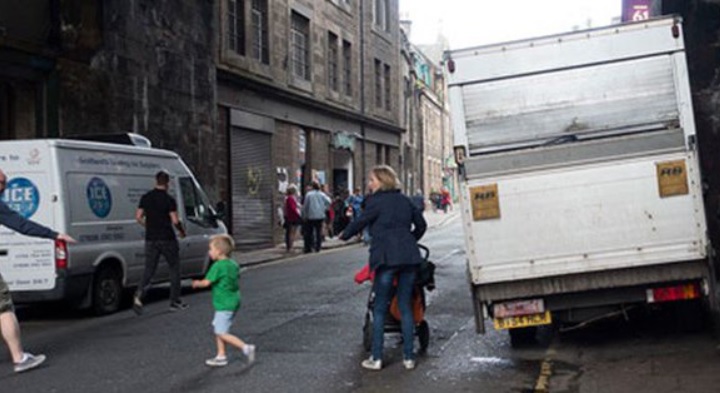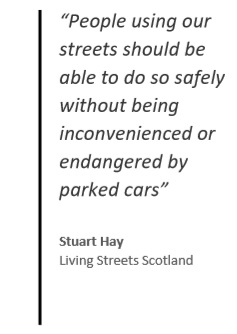
A national ban on pavement parking would send out a clear message that pavements are for people – according to Living Streets Scotland.
The Scottish Parliament is currently considering new legislation to help make the nation’s transport network ‘cleaner, smarter and more accessible than ever before’ – including a ban on pavement and double parking.
The Transport (Scotland) Bill – first introduced by Derek Mackay MSP in June 2018 – also focuses on low-emission zones, road works and bus services.
 Providing evidence to the Scottish Parliament’s Rural Economy and Connectivity Committee (RECC), Living Streets Scotland has submitted a robust call for car-free pavements – with no loopholes.
Providing evidence to the Scottish Parliament’s Rural Economy and Connectivity Committee (RECC), Living Streets Scotland has submitted a robust call for car-free pavements – with no loopholes.
Stuart Hay, director of Living Streets Scotland, said: “Plans to outlaw footway parking should be supported by MSPs from all parties that care about people with disabilities, older people, parents and children.
“A national ban sends a clear message that pavements are for people. And people using our streets should be able to do so safely without being inconvenienced or endangered by parked cars forcing them off the pavement and into the road.”
The RECC is currently scrutinising the legislation following the consultation period. Living Streets Scotland will be giving further evidence to the RECC on 7 November.
In September, a host of charities, campaign groups and other organisations, along with nearly 17,000 member of the public, urged the UK Government to outlaw ‘dangerous’ pavement parking.
In June, a ban on pavement parking was among the measures recommended in a new manifesto published by an alliance of cycling and walking organisations.
I would urge caution on this issue. Many years ago when I was involved in road design, we came across places, particularly in rural areas with ‘terraced houses or cottages’ allowing no vehicular access between, the area between a property and the edge of the carriageway was in the ownership of the property owner and used by the property owner for vehicle parking.
In some instances the local authority without purchasing the land had constructed a kerbed pavement on that land with no objections from the property owner, as it enhanced the property frontage, but when the local authority moved to further improve that area, the property owner then raised objections to the removal of their parking facility. I am sure that there are still many locations where this still exists, not only in Scotland but in many other areas of the UK.
Unfortunately the people involved in the alliance of cycling and walking organisations and today’s MPs, are not of an age to remember this possibility. Saying all this I agree that the obstruction of pavements, particularly to pram and pushchair users, physically challenged pedestrians and wheelchair users should be discouraged to the maximum, but using legal methods could open a hornets nest in some areas.
Derek C Donald, Inverness
+2
There can be no good reason to park on the footway. Here, the Council paints lines and permits parking on footways so pedestrians are forced to cross the road or walk in the carriageway. Wheelchairs can’t get through. All so that white vans can pass, to speed their deliveries. High pollution, obesity, and policies to encourage walking and cycling. But implementation shouts a contrary message.
Peter Treadgold, London
+1
Point take chaps, although more a case of deterring unnecessary car usage than car ownership.
On the other side of the coin however, in the UK starting in the 1980s billions have been spent nationally on re-configuring road layouts and retro-providing vehicle access and driveway parking for residents of Radburn-type housing estates where, until then, none existed and only footpath access to homes was provided.
As far as ‘manipulating reduced car ownership goes’, if I was looking to move to a new house or flat and limited, or no off-street parking was available, I wouldn’t sell the car, I’d just look elsewhere. If one wasn’t reliant on a car (not everyone is), it probably wouldn’t matter, whereas proximity to facilities and public transport no doubt would.
Hugh Jones
+1
Hugh
I agree with your last point, not here to justify that.
The idea of trying to deter car ownership by constraining the number of parking places in new residential developments was quite popular with certain think tanks and sustainable champions in the years from the early 2000s to 2010 or thereabouts. It is STILL a current public health policy recommendation.
In Wales for new developments we generally work to one parking space per bedroom unless a case can be made for less parking provision (e.g. proximity to bus routes, town centre etc), which fits quite well with TAN 18.
Guzzi, Newport
+4
I live in such a community, Hugh.
It got to the point where my local authority had to admit that their plan for reducing car ownership had failed – and revised upwards the amount of parking spaces that would need to be catered for – rather dramatically.
Which means that plans for about 150 flats near the centre of my town were held up as the council had to figure out whether or not it could approve the plans for these flats – the county council guidance required nearly 520(!) parking spaces, and only 90 or so were provisioned.
David Weston, Corby
+4
Which ‘years’ and where are these residential communities, so designed, Guzzi? How did they get planning permission? I don’t think developers can reasonably be expected to provide off-street parking for an unlimited number of individual household’s cars. Where off-street parking is available, some residents still choose to park outside, with two wheels on the footway – why?
Hugh Jones
+1
For years many urban planners deliberately designed residential communities with less parking spaces than needed in an attempt to manipulate reductions in car ownership. Such crackpot ideas rarely if ever worked and failed those communities, leaving them with problems that will blight their neighbourhoods for generations to come. So whose fault is it ultimately?
Guzzi, Newport
+5
Some councils paint lines on pavements, indicating parking on the pavement up to the line will be tolerated. It is a practical solution in some places. For many others the line is merely theoretical with enforcement officers expected to use discernment. Illegal? Perhaps but is it any more so than promoting a signed only 20mph speed limit whilst not expecting people to comply with it and considering speeds “as low as 24mph” in a default 20 a success.?
Pat, Wales
+5
> It is illegal to drive on the pavement without doing so to enter an authorised parking space
With the exception of Greater London, one must be informed that one cannot park on the footpath. Thus, one could argue it’s an authorised parking space unless signs or road markings dictate otherwise – and your parking there won’t cause an obstruction.
> And isn’t incitement to break the law a crime?
And?
David Weston, Corby
+2
Pat
It is illegal to drive on the pavement without doing so to enter an authorised parking space. So how do you propose that drivers park on the pavement without driving on it? Or are you proposing that drivers break the law to do so?
And isn’t incitement to break the law a crime?
Rod King, Lymm
--6
I think it may help if we move this conversation on to a more nuanced level.
-Don’t ever park so as to block the road to other vehicles especially larger emergency vehicles like fire engines and ambulances.
Don’t ever park so far on the pavement that it blocks the pavement and prevents pedestrians, cyclists, mobility scooter users, double buggies etc from passing without obstruction.
If space is tight and you can meet these two don’ts, then parking partly on the pavement may well be tolerable, even though not ideal.
Pat, Wales
+4
If you find you can’t park on the highway without restricting others then ..you can’t park there and you have to find somewhere else. As David says, all vehicles, which obviously includes emergency vehicles, have a greater right to move along that particular road than those who have chosen to park on it restricting movement – on the carriageway AND the footway.
Hugh Jones
+6
Pat
Surely it’s a case of people acquiring cars for which they have no local on-road parking space and expecting pedestrians to suffer the consequences of their pavement parking. Add to this those who have garages and drives but prefer to use them for gardening equipment and storage rather than their cars.
If the roads aren’t suitable for road parking without obstructing emergency vehicles then quite simply they are not suitable for parking. People need to limit their car acquisition based on their ability to park them responsibly.
Rod King, Lymm
--3
I think we would all like to see pavements not being blocked by parked cars. I hope MSPs will insist that any vote to ban cars on pavements is accompanied by a workable solution to the lack of available parking. Yet another case of campaigners ignoring the knock-on implications of their campaign?
Pat, Wales
+6
> A national ban sends a clear message that pavements are for people
…and that the roads in residential areas are not for emergency vehicles.
I wish on no-one the feeling of fear that comes with summoning the emergency services in a life threatening situation, and having to wonder whether or not ambulances will be able to fit through. Thankfully they did, that tim–
> with no loopholes
oh, perhaps not, I guess the ambulance will just sit in the middle of the road then!
> In September, a host of charities and organisations, along with nearly 17,000 member of the public, urged the UK Government to outlaw ‘dangerous’ pavement parking.
It already is illegal. What are they intending to do, make it even more illegal? Illegal-er?
David Weston, Corby
+3